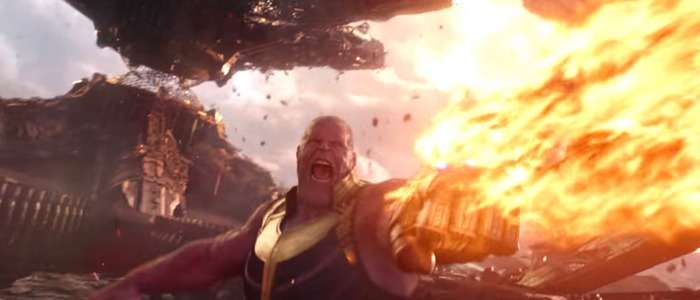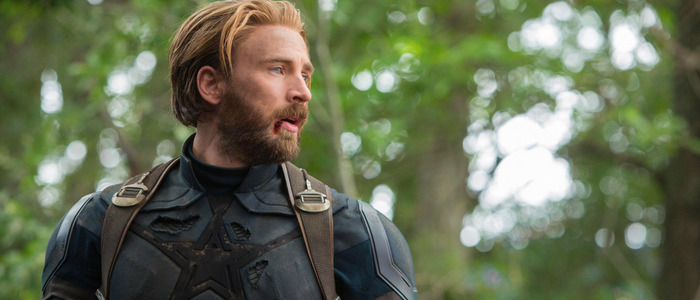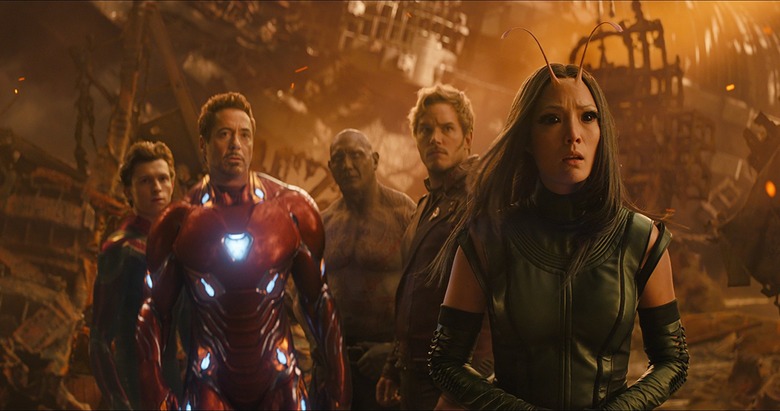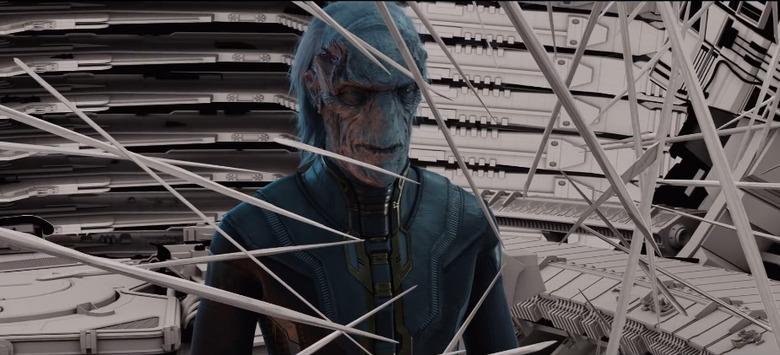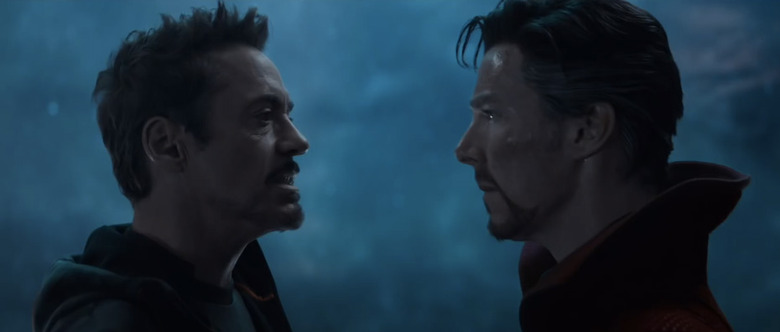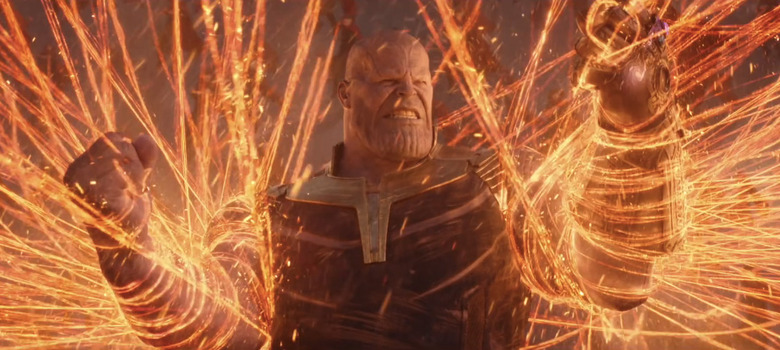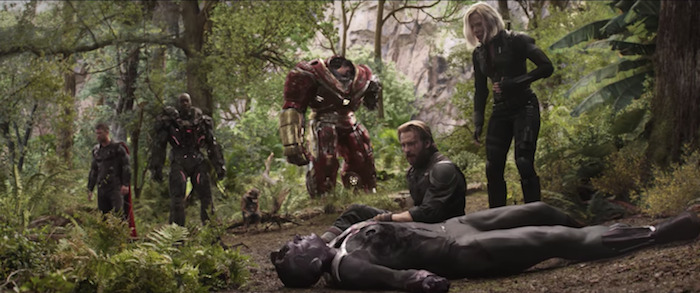Road To Endgame: 'Avengers: Infinity War' Puts Everything Earth's Mightiest Heroes Stand For At Stake
(Welcome to Road to Endgame, where we revisit the first 22 movies of the Marvel Cinematic Universe and ask, "How did we get here?" In part two of our look at Avengers: Infinity War: confused action, and a cliffhanger that asks, "Who are the Avengers?")[Read part one of our giant look at Avengers: Infinity War here]The first big action scene in Avengers: Infinity War unfolds when Bruce Banner (Mark Ruffalo), Tony Stark (Robert Downey Jr.), Stephen Strange (Benedict Cumberbatch) and Wong (Benedict Wong) rendezvous in Manhattan. It's a fun excursion filled with setups about Infinity Stones, character decisions and the plot at large. Though by swiftly ensuring all civilians are out of the picture (unlike The Avengers and Avengers: Age of Ultron, where they were a constant presence), the scene is robbed of immediate stakes beyond the Stones themselves. Our heroes simply battle on empty streets.The Avengers, in theory, fight to protect innocent people. But by failing in to dramatize this — both on Earth and elsewhere — the film misses a vital opportunity to contrast the Avengers' actions with those of Thanos (Josh Brolin) and his henchmen (the nefarious Black Order), whose collective mission is genocide.
The Battle On Titan
In New York, Tony Stark flies out the gate with his most advanced technology yet. His fluid nanotech suit conjures an entire arsenal of weapons, indecipherable from magic. It's a treat to discover, and since Stark plays all his cards within the film's first hour, it sets up his desperation while battling Thanos on Titan. This battle, wherein Spider-Man (Tom Holland), Stark, Doctor Strange and the Guardians fight an uber-powered Thanos has moments of dazzling spectacle. However, the Avengers' plan prior to Thanos' arrival isn't made clear in the narrative. The result is characters haphazardly attacking the villain and trying to pull off a Gauntlet heist that we, the audience, aren't made privy to beyond the vagaries of "defeat Thanos." That is, until Doctor Strange instructs his cape to prevent Thanos from closing his fist, several minutes into the scene (Though, the other characters' goals remain uncertain until Thanos is apprehended).In contrast, the climactic battles of both prior Avengers films featured clearly defined objectives and physical geographies. This imbued each action beat its own weight and momentum. The consequences of even minor failures were clear in the moment; in The Avengers, the aliens had to be contained to a defined perimeter, lest the invasion go global before the portal could be closed. In Avengers: Age of Ultron, stopping Ultron's drones from reaching the city's center was imperative, to prevent them from blowing up Sokovia before its citizens were rescued. Whereas in Avengers: Infinity War, in which Thanos can't enact his plan until he has all six Infinity Stones, the moment-to-moment stakes and goals are only clarified after each action beat has passed (owed, in part, to the abilities of each Stone being ill-defined).The Titan scene begins with our foreknowledge that the characters are hiding. There's little doubt that Thanos isn't the protagonist or point-of-view character, so we ought not to be surprised by the assault. But each Avengers' physical relationship to Thanos isn't framed until they attack him, after which they zip off-screen, not to be seen again until they attack him once more. Assemble these action beats in any order, and the result is nearly identical.This revolving-door problem rears its head in Wakanda too.
The Battle In Wakanda
There are only eight minutes between the Wakanda battle kicking off and the Avengers reaching their low-point (with other scenes in between), necessitating Thor's arrival during what feels like a climactic escalation. As soon as Thor shows up, he decimates the surrounding aliens with his newly acquired powers, and yells "Bring me Thanos!" A few seconds later, the film cuts to a closeup of Thanos arriving through one of his portals. However, it then pulls back to reveal he's on Titan, rather than Earth. A minor oddity in the grand scheme of things, though one with a confused correlation, causality and spatial awareness, and a decision emblematic of the film's slapdash scene-to-scene editing — especially since visual effects company Weta Digital had worked more visual information for this scene, the use of which would've offered greater narrative clarity:
This moment of Thanos arriving seemingly offers more exciting, more immediate drama, before the deflating realization that Thor and Thanos have not, in fact, crossed paths. And while it isn't as disorienting upon re-watch, the timing still feels awkward, especially since Thor's arrival on Earth is one of the film's most (and only) rousing moments. It's even marked by the Avengers' signature musical theme.Instead of any payoff to Thor's tragic arc while the iron is still hot (he's just nearly killed himself forging a new axe), or even any subversion of what feels like Thor's moment of victory, the film continues to wheel-spin. It delays its drama by having Thor — after his incredible power-up and initial strike — unmemorably plough through floating alien ships, shot with little sense of scale. In the meantime, Captain America (Chris Evans), Black Panther (Chadwick Boseman) and the other Avengers punch and shoot at alien hordes.
Orienting Action
The battle on Titan feels inventive for a handful of moments. Doctor Strange conjures butterflies and mirror dimensions, while Thanos attacks with bats and black holes. It's a fitting visual contrast between two characters willing to sacrifice people for Infinity Stones, each for opposing reasons. But the scene soon resumes the standard kicking and punching, divorced from character. This issue manifests tenfold in the Wakanda battle, which has little sense of geography, even though the Avengers' purpose is protecting The Vision (Paul Bettany) and his Mind Stone at the city's center.The Avengers either fight in sweeping landscape shots of indecipherable CGI blobs, or in closeups of punching, both of which fail to orient them in time and place. Even as they punch in tight shots, neither the characters immediately around them, nor the geography in the background, conveys the simple information of where they are, or how far the aliens have progressed.The heroes and villains' proximity to the city, and thus their proximity to The Vision, is vital, since he holds the last piece of the Infinity Gauntlet. Instead, the scene is robbed of the tension it ought to have. The action beats never stray from interchangeable shooting and fisticuffs; a far cry from the story-centric extensions of character in The Avengers' climactic battle.There's little causality between moments in the Wakanda fight. It's mayhemic, but not in a way that builds tension. Once The Vision enters the battlefield, and once Thanos arrives soon after, there's no indication of where any of the other Avengers are in relation to these characters, or where the fight even takes place.You'd be forgiven for assuming this climax occurs in the forest outside Wakanda's dome. Take a closer look, however, and you'll notice it unfolding at the foot of Wakanda's palace, where The Vision was being guarded (he subsequently tumbled from its window). This is tough to follow at first, and it isn't a minor detail either; one forest is where the aliens began advancing from, while the other was their end goal. The scene, therefore, isn't even able to convey the degree to which the Avengers have lost or won, something that ought to be readily apparent just by glancing at a battle scene.The Avengers enter this climactic sequence one by one, whether to protect The Vision from Corvus Glaive, or to fight an arriving Thanos. But like the battle on Titan, these moments are self-contained. They're action beats in isolation; the tension is limited to who's standing in front of Thanos in a given moment, rather than heroes having to beat a ticking clock and make their way into this battle from a distance.The film brings together dozens of characters, but they cease to exist the minute they aren't on screen. This problem often extends to how they're characterized; some depend on assumptions based on prior films, while newer additions are barely introduced at all.
Robotic Characters
The Black Order is a key example of the film's lacking approach to character. Proxima Midnight, Cull Obsidian, Corvus Glaive and Ebony Maw — Thanos' henchmen from the comics — are rebranded "children of Thanos." This was likely to align them with Thanos' characterization in Guardians of the Galaxy Vol. 2, in which he's a controlling, abusive father.Unlike their sisters Gamora (Zoe Saldana) and Nebula (Karen Gillan), who escaped their father's grasp, the Black Order remains loyal to Thanos. And yet, the they're indistinguishable from run-of-the-mill henchmen, even in a story where Thanos' complicated, abusive dominion over his daughters plays a vital role. Except for Ebony Maw (referred to once, as "The Maw"), they aren't even given names, let alone coherent motivations or interior lives that might make them foils to Gamora and Nebula.The Vision, too, is robbed of a coherent story, despite being a centerpiece. In his last appearance, Captain America: Civil War, he bowed out of the conflict upon realizing that he was becoming more human, and thus, more emotional. However, in Avengers: Infinity War, he's entirely stagnant, and he's introduced later in the film than he should be. His relationship with Wanda (Elizabeth Olsen) has dramatic potential — a minor flourish like The Vision fumbling his words is both sweet and distinctly human — but introducing their romance after the New York battle brings all momentum to a screeching halt.This idea that The Vision might be more human than he thought is rarely conveyed, even in a story about whether or not human lives ought to be traded. When Corvus Glaive's blade pierces his skin, The Vision remarks that this shouldn't be possible. Though it's unclear if this is a function of becoming "more human" (which hasn't yet manifested physically) or simply because Glaive has a really strong weapon. Once again, as with the failure to define the limits and powers of the Infinity Stones, the drama in a given moment is unclear.When Bruce Banner talks of The Vision's mental makeup — the Mind Stone, J.A.R.V.I.S., Ultron, Stark and Banner himself — this ends up being mere theory to facilitate the plot, wherein the Avengers travel to Wakanda to surgically separate The Vision from the Stone. However, in Avengers: Age of Ultron, the specifics of who and what made up The Vision informed his very philosophy. This time, these specifics are treated neither as an aspect of The Vision's identity, nor his sense of self as he becomes more human, nor anything he might have to reckon with before accepting his mortality. Though while Infinity War drops the ball on several characters, there are just as many who prosper. The film's most enjoyable new dynamic, for instance, is that between Tony Stark/Iron Man, Peter Parker/Spider-Man and Doctor Stephen Strange.
The New York Avengers
Stephen Strange and Tony Stark are often compared. They both began as egotistical geniuses, but Strange, in his first film, learns more and goes through more character development than Stark does in all his eight appearances. This is by design; Strange is a learner by nature, while Tony Stark, in his desperation to atone for the past, replaces old mistakes with new ones.Peter Parker is one of those mistakes.Stark is re-introduced during his morning jog with Pepper Potts (Gwyneth Paltrow). They're back together, engaged, and talking about having kids, but Potts is hesitant, since Stark refuses to lay down his guns. He houses his Iron Man suit on his chest — in place of his arc reactor, the very thing he removed to convince himself that Potts would be his priority — and he rushes back into battle whenever danger appears. Stark flies into space once more. When he did so in The Avengers, his goodbye call to Potts failed to connect. This time however, it goes through; they're even closer as a couple, so Stark feels like he has more to lose.Stark is eager to take the fight directly to Thanos, the very "endgame" he spoke of in Avengers: Age of Ultron, after being shown terrifying visions of the future. His eagerness to act is mirrored by Parker's, who follows Stark all the way to Titan, despite being ordered to stay behind. Stark, who was blamed for Charles Spencer's death in Sokovia, has been trying to avoid collateral damage. But in giving his protégé a new suit to protect him, Stark — who kicks off an arms race each time he creates new defenses — inadvertently facilitates Parker's decision to attack.Stark wants to be a parent. He claims to be ready for this next step, one that would effectively bring his story to an end. But at the beginning of the film — and especially in its climax, when Parker dies in his arms — the question rears his head: Does Stark deserve the responsibility?In contrast, Doctor Strange is nothing if not responsible. When Stark attacks, Strange defends. Where Stark grows increasingly frustrated, Strange remains composed. Strange's sole duty is to protect the Time Stone, which he claims he'll do even if it means letting Stark and Parker die. However, after witnessing over 14 million possible futures, only one of which leads to victory, Strange changes his tune.Until Avengers: Endgame elaborates on what Strange saw, there's a glaring mystery at the heart of his narrative; however, it falls perfectly in line with the story thus far. In Doctor Strange, he began to accept pain and failure — albeit with the backdoor of time-travel resurrection — after his mentor, The Ancient One (Tilda Swinton) was killed. In the moments before she died, The Ancient One spoke of changing the future innumerable times in order to avoid the outcome of her death. She could not, and it appears, neither could Strange.Strange readily gives up the Time Stone to save Tony Stark, despite having claimed otherwise. This hints at future narrative possibilities; what did Strange see that changed his mind? What is Stark's role in humanity's future? Only Strange appears to know. Like Thanos and the Red Skull, Strange is cursed with knowledge (a seeming consequence of holding the Infinity Stones), even though Stark is inexplicably saddled with this distinction. But even without these future possibilities being revealed, Strange's decision to submit the Time Stone hinges on his acceptance of death — something he seems prepared for even before Thanos arrives.Though, this is more of a conclusion based on prior films, rather than anything expressed in Infinity War. One hopes that Avengers: Endgame will clarify the meaning and emotion underlying Strange's arc. But it's an arc that won't ever feel whole in a film that is, in itself, designed to be incomplete.Avengers: Infinity War is very much the first half of a story. It ends on a cliffhanger, one that not only kills most of its main characters, but leaves the remaining Avengers without the very thing that makes them heroes: the ability to meaningfully sacrifice.
The Snap
"The Snap," as Thanos' genocide has become colloquially known, had a pretty sizable cultural impact. Through memes and joking references, yes, but also through the shared experience of a massive blockbuster ending on such unrelenting tragedy.Likely a surprise to those unfamiliar with the comics (the vast majority of moviegoers), the film's version of this universal culling was rightly altered from its source material. Rather than disappearing instantly and altogether, as they did in Infinty Gauntlet #1, the characters' deaths are staggered. They fade away slowly and one by one, giving those in their vicinity the opportunity to react. The result was certainly memorable, but it revealed both major strengths and flaws of the series' long-term worldbuilding.Bucky Barnes (Sebastian Stan) is the first to go. He collapses into dust from Steve Rogers' point of view, though Rogers hardly responds like a man who's just seen his lifelong best friend (of nearly a century) die horribly and inexplicably. Chris Evans is no doubt a fantastic actor, but it wouldn't be a leap to assume the drama was stifled because the filmmakers withheld the script; they only told the cast about this scene the day it was meant to be shot. Regardless of the actors' prep-time, Barnes only shows up in a handful of moments prior to his death. His arrival in Wakanda after Captain America: Civil War, and his apparent attempts at recovery from brainwashing after Black Panther are relegated to post-credit scenes. The drama in Infinity War affords Barnes nothing by way of character, even though re-discovering himself is vital to his and Rogers' stories across four different films. When Barnes collapses into dust, Rogers doesn't get so much as a reaction shot.Thankfully, this issue doesn't extend to every single death. While Groot's sacrifice to create Thor's axe is framed haphazardly — both the missing handle, and Groot's decision to amputate his arm, have little prior setup — his death feels like it matters because his friend Rocket has much to lose, as expressed in conversations with Thor.Similarly, Peter Parker's death hits the hardest, not just because of Tom Holland's improvised, instantly-iconic dialogue (Parker's death was drawn out in the film thanks to Holland's performance), but because his death matters to Tony Stark. It's Stark's very legacy as an Avenger, and as a future parent, crumbling right before his eyes, in the form of an innocent child he was meant to protect.Okoye's (Danai Gurira) sole duty was to protect the Black Panther. Her confusion when her king withers away — contrasted with Wanda's acceptance as she sits by The Vision, her final expression mirroring his — are fitting as well. Though with each individual character granted such massive death scenes, some were bound to be less impactful. For instance, the final words and moments of the Falcon (Anthony Mackie), Drax (Dave Bautista), Quill (Chris Pratt) and Mantis (Pom Klementieff) don't feel like they have the same emotional connections to the characters around them.However, as the remaining characters gather to take stock of what's happened, the emotional totality comes into view. These deaths are likely temporary, but the film, despite being a first chapter, has a sense of finality. Its penultimate scene ends on a group shot of the Avengers, like so many other tableaus in the series — only rather than victorious, they're left completely devastated. Steve Rogers' "Oh god" lands with a thud.
Marvel’s Endgame
A lot of Avengers: Infinity War works. Like most Marvel movies, it's filled to the brim with great character moments, though they aren't always assembled with narrative coherence. The film's key problem however, in the broader context of the Marvel Cinematic Universe, is the ways its heroes are framed against its villain.The Avengers are implicitly on the side of life, as The Vision claimed he was in Avengers: Age of Ultron. But the extent of this framing was enough at the time, in a film where Ultron's nihilism needed a life-affirming foil. Thanos, however, is a villain that demands more specificity, owing to his specific plan. Regardless of his twisted ideology, Thanos' goal involves radical change; in his mind, the outcome is a universe that has been significantly bettered.Throughout the series, the Avengers have almost never sought to challenge existing norms (Black Panther being the notable exception). This through-line manifests especially in films funded and approved by the U.S. Department of Defense — Iron Man, Iron Man 2, Captain America: The Winter Soldier and Captain Marvel — wherein the powers that be, often American military and government structures, are framed as necessary or desirable in a world where war is only caused by industry or by hostile foreign forces.And while films like Avengers: Infinity War aren't bound by military-approved scripts, their narratives are impacted by the ripple-effects of Marvel movies that are also military propaganda. The series, from its very foundations, rarely features characters seeking to improve the state of the world. The Avengers merely retaliate against threats that might upset the equilibrium.Where Thanos seeks solutions to the problems of overpopulation (poverty, famine and, one would assume, war), the Avengers' actions or even perspectives in this vein are never contextualized. They neither act upon nor even comment on the "normal" state of things, nor is their (presumed) ineffectualness in improving the world commented on by Thanos.What good are these superheroes doing, one wonders, by holding on to the Infinity Stones? Even the Avengers who aren't Stone keepers don't seem to want to improve things, save for Black Panther's small-scale outreach. They aren't so much heroes as they are protectors of the status quo; the lesser of two evils, wreaking destruction even as they try to prevent it. There's little sense of what these characters actually do when there isn't an apocalypse to thwart; what have Captain America, Black Widow and The Falcon been doing from the shadows since the events of Civil War? This is less a plot-hole and more a glaring omission in establishing who these characters are, and more importantly, how they function in the context of Thanos, his plan, and the film's own themes. Thanos has fought them and defeated them, but one wonders if he'll truly change them.Perhaps this is something the film's follow-up will tackle come April 26th — or perhaps not, though it should, given what's come before. After all, this enormous finale ought to be about regaining what was lost: Friends. Allies. Narrative arcs. The very ability to act heroically. And with everything turned on its head, it'll be interesting to see if the Avengers seek to return the world to its original status quo, or if they fight to create something better.In Avengers: Endgame, who the Avengers are, and what they stand for, is at stake.

